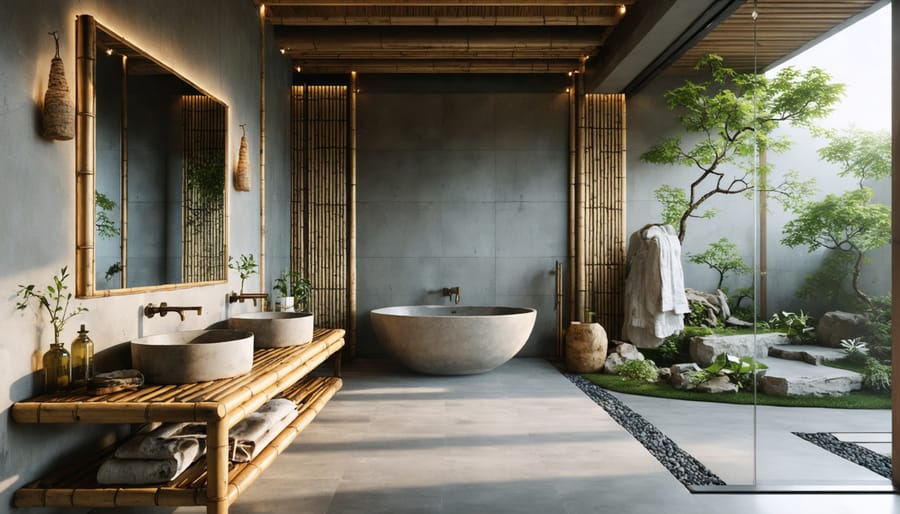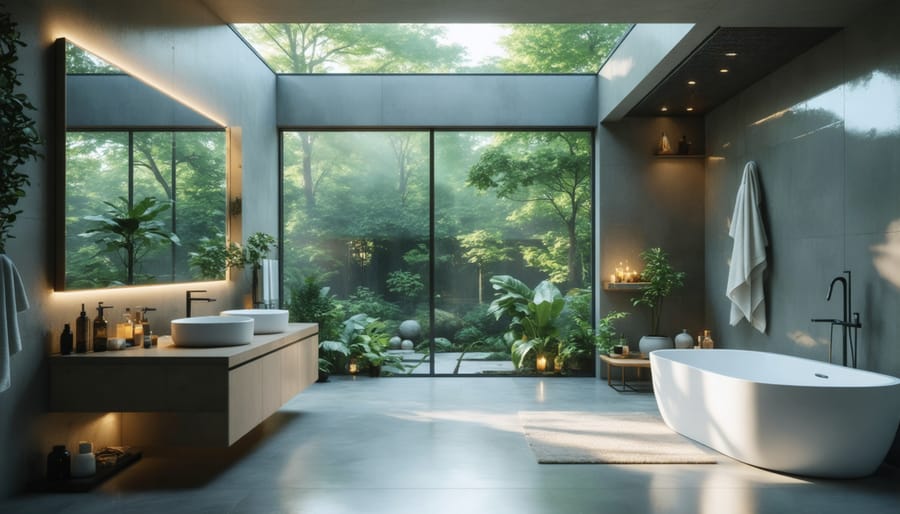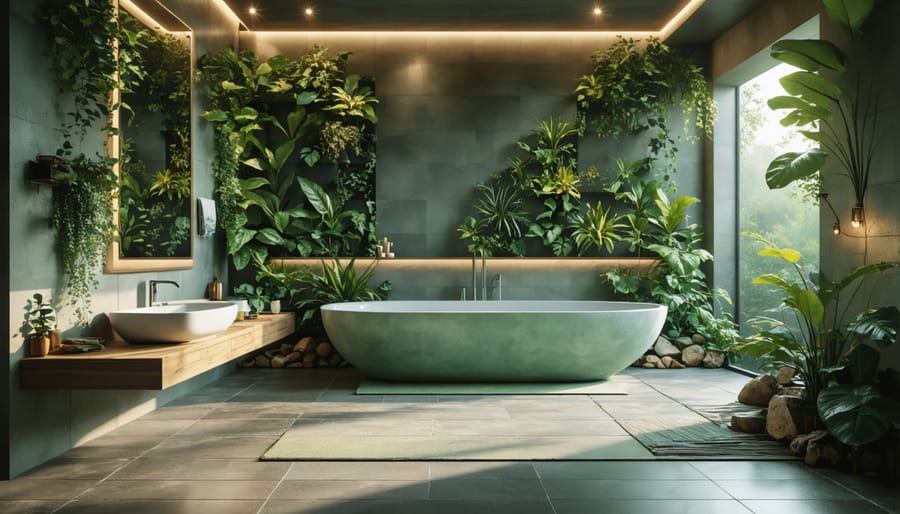Transform your bathroom into a serene, eco-conscious sanctuary by combining organic materials with sustainable design principles. Natural stone tiles, reclaimed wood elements, and living plants create a harmonious space that connects you with nature while reducing your environmental footprint. Modern organic bathroom design goes beyond aesthetics – it embraces non-toxic finishes, water-saving fixtures, and renewable materials that promote both personal wellness and planetary health.
Today’s conscious homeowners recognize that organic bathroom design isn’t just a trend; it’s a thoughtful approach to creating spaces that nurture both body and soul. From bamboo vanities and cork flooring to low-flow showerheads and natural lighting solutions, every element serves a dual purpose of sustainability and style. The result is a luxurious yet environmentally responsible retreat that brings the calming essence of nature indoors while maintaining the sophisticated functionality modern life demands.
Whether you’re planning a complete renovation or seeking simple organic touches, this guide will walk you through the essential elements of creating a bathroom that honors natural materials, promotes sustainability, and delivers the peaceful atmosphere you deserve. Let’s explore how to blend eco-friendly materials, biophilic design principles, and water conservation features into a space that’s both beautiful and environmentally conscious.
Natural Materials That Define Organic Bathroom Design

Sustainable Wood Elements
Incorporating sustainable wood elements into your bathroom design brings warmth and natural beauty while maintaining eco-friendly principles. Bamboo stands out as a fantastic choice, offering exceptional durability and moisture resistance. Perfect for vanity countertops, shower mats, or storage solutions, bamboo regenerates quickly, making it one of the most sustainable wood options available.
Teak, though more premium, proves its worth through outstanding water resistance and natural oils that prevent mold growth. Consider using teak for shower benches, bath mats, or even custom-built vanities. Its rich, golden-brown color deepens over time, adding character to your space.
Reclaimed wood tells a unique story while giving new life to existing materials. From weathered barn wood mirror frames to vintage cabinet doors repurposed as shelving, these elements add rustic charm and authenticity to your organic bathroom design. Just ensure any reclaimed wood is properly sealed to withstand bathroom humidity.
Pro tip: When selecting wood elements, look for FSC certification to ensure your materials come from responsibly managed forests. Consider mixing different wood types and textures to create visual interest while maintaining a cohesive natural theme.
Stone and Natural Tiles
Natural stone brings an authentic, organic feel to your bathroom while offering incredible durability and timeless appeal. Popular options include slate, with its dramatic layered appearance, and limestone, which adds a soft, earthy warmth to any space. Marble, though requiring more maintenance, delivers unmatched elegance with its distinctive veining patterns.
For a more sustainable choice, consider reclaimed or recycled stone tiles, which minimize environmental impact while adding character to your space. These tiles often come with unique weathering patterns and natural variations that tell a story of their previous life.
When selecting natural stone, opt for locally sourced materials when possible to reduce transportation emissions. Look for suppliers who practice responsible quarrying and those who offer stones with natural finish options rather than heavily processed surfaces.
For grout lines, choose eco-friendly options made from natural materials or recycled content. Consider installing your tiles with non-toxic adhesives and sealants to maintain the organic integrity of your bathroom design. Remember that while some natural stones require more careful maintenance, their longevity and timeless beauty make them a worthwhile investment for your organic bathroom.
Plant-Based Elements
Adding living plants and natural fibers to your bathroom creates a serene, spa-like atmosphere while improving air quality and bringing the outdoors in. Start with moisture-loving plants like peace lilies, bamboo, or orchids that thrive in humid environments. Place them on windowsills, floating shelves, or hanging planters to maximize space while creating visual interest at different heights.
Natural fibers add warmth and texture through thoughtfully chosen accessories. Consider incorporating jute bath mats, bamboo towel racks, or woven storage baskets. These elements not only look beautiful but are also sustainable and biodegradable. For shower curtains, opt for organic cotton or hemp materials, which resist mold and mildew naturally while providing an eco-friendly alternative to synthetic fabrics.
When selecting planters, choose materials that complement your organic design theme, such as terracotta, ceramic, or reclaimed wood. Remember to ensure proper drainage and ventilation for your plants, and position them where they’ll receive adequate natural light. For bathrooms with limited natural light, consider low-light plants like snake plants or pothos, which can still thrive while purifying the air.
Water-Conscious Features
Low-Flow Fixtures
Making your bathroom more eco-friendly starts with smart water-saving solutions, and low-flow fixtures are leading the way in modern bathroom design. These innovative fixtures can reduce your water consumption by up to 50% without compromising your daily comfort.
Start with the shower, where a high-quality low-flow showerhead can deliver a satisfying spray while using just 1.5 gallons per minute, compared to the standard 2.5 gallons. Look for models with adjustable settings that let you customize your shower experience while maintaining efficiency.
For faucets, aerators are game-changers. These small devices mix air with water to maintain pressure while reducing flow. Modern bathroom faucets with built-in aerators use as little as 0.5 gallons per minute, making hand-washing and teeth-brushing more sustainable.
Don’t forget about the toilet, which traditionally accounts for the most water usage in the bathroom. Dual-flush toilets offer two options: a light flush for liquid waste (using about 0.8 gallons) and a full flush for solid waste (around 1.6 gallons). Some newer models even feature sophisticated pressure-assisted technology for superior performance.
The best part? These fixtures often pay for themselves through reduced water bills within the first year, making them both environmentally and financially smart choices for your organic bathroom design.

Greywater Systems
Greywater systems are a game-changing addition to any organic bathroom, allowing you to reduce water waste while maintaining an eco-friendly lifestyle. These innovative systems capture and filter water from your shower, bathroom sink, and even your bathtub, making it available for secondary uses like toilet flushing and garden irrigation.
Installing a greywater system can be as simple or sophisticated as you prefer. Basic systems might redirect shower water to a holding tank for toilet flushing, while more complex setups can include filtration systems and automated distribution networks. For beginners, consider starting with a simple shower-to-toilet system, which can save thousands of gallons of water annually.
Here’s what to keep in mind when planning your greywater system:
– Choose biodegradable, natural cleaning products to ensure the recycled water is safe for secondary use
– Install appropriate filters to remove hair and soap residue
– Consider local building codes and regulations before installation
– Plan for regular maintenance and cleaning of filters
– Include clear labeling of greywater pipes and fixtures
Expert tip: Connect your greywater system to your garden irrigation for a truly sustainable solution. Plants love slightly soapy water, and you’ll see the benefits in your water bill and your garden’s health. Remember to use only plant-friendly, natural soaps and avoid products containing bleach or harsh chemicals.
Natural Lighting Solutions
Skylights and Windows
Natural light can transform your organic bathroom into a serene sanctuary while reducing energy consumption. Strategically placed skylights offer an unobstructed view of the sky, creating a seamless connection with nature and flooding your space with warm, natural illumination throughout the day.
When planning skylight placement, consider installing them above key areas like the shower or bathtub to maximize their impact. Solar tubes are an excellent alternative for spaces where traditional skylights aren’t feasible, channeling sunlight from your roof through reflective tubing.
For windows, opt for energy-efficient designs with double-pane glass to maintain temperature control while letting in abundant natural light. Privacy can be maintained through frosted glass, bamboo blinds, or strategically placed plants. Consider installing windows at varying heights to create interesting light patterns and enhance ventilation.
Pro tip: Position mirrors opposite windows to amplify natural light and create the illusion of more space. For darker bathrooms, light-colored surfaces and reflective materials can help bounce light around the room. Remember to include proper ventilation options in your window design to manage moisture levels effectively while maintaining your bathroom’s organic appeal.

LED and Energy-Efficient Options
When it comes to illuminating your organic bathroom, LED lighting stands out as a perfect blend of efficiency and eco-consciousness. These energy-saving fixtures consume up to 90% less power than traditional bulbs while lasting significantly longer, making them an excellent choice for environmentally conscious homeowners. To create a harmonious organic space, explore sustainable lighting options that complement your natural design elements.
Consider installing LED strip lights beneath floating vanities or along shower niches to create a soft, ambient glow that mimics natural light. Opt for warm-white LEDs (2700-3000K) to maintain the cozy, organic feel of your space. Smart LED fixtures with dimming capabilities allow you to adjust light levels throughout the day, reducing energy consumption while creating the perfect atmosphere for different activities.
For task lighting around mirrors, choose LED sconces or bar lights with high CRI (Color Rendering Index) ratings to ensure accurate color representation. Many manufacturers now offer fixtures made from recycled materials or sustainable components, furthering your bathroom’s eco-friendly design. Remember to position your lights strategically to maximize their effectiveness while minimizing the number of fixtures needed, reducing both energy consumption and environmental impact.

Organic Textures and Colors
Earth-Toned Color Palettes
Creating a serene, organic bathroom starts with selecting the perfect earth-toned color palette. Nature’s colors provide a calming foundation that seamlessly integrates with other earth-friendly decor elements while establishing a spa-like atmosphere in your space.
Start with warm neutrals as your base colors – think sandy beiges, soft taupes, and gentle browns. These shades work beautifully on larger surfaces like walls and floors, creating a grounding effect that mirrors natural landscapes. Layer in deeper earth tones like terra cotta, sage green, or warm clay to add depth and visual interest to your design.
For a harmonious look, incorporate these colors through various materials and textures. Consider using natural stone tiles in varying brown tones, wooden elements in rich walnut or bamboo, and organic textiles in complementary earthy hues. The key is to blend different shades while maintaining a cohesive look.
Don’t shy away from adding subtle contrasts – soft whites can brighten the space while still maintaining the organic feel. For accent colors, look to nature for inspiration: forest greens, riverbed grays, or desert sunset oranges can add personality while staying true to the earth-toned theme.
Remember to test your color choices in different lighting conditions, as natural and artificial light can significantly impact how earth tones appear throughout the day. This attention to detail ensures your organic bathroom maintains its intended atmosphere regardless of the time.
Textural Elements
Natural textures play a vital role in creating an authentic organic bathroom design, helping to forge a deeper connection with nature. Start by incorporating wood elements through features like bamboo bath mats, teak shower benches, or reclaimed wood shelving. These materials not only add warmth but also bring a sense of the outdoors inside.
Stone textures can transform your bathroom into a spa-like retreat. Consider pebble floor tiles in the shower area, slate wall accents, or a natural stone countertop. The varied surfaces and irregular patterns create visual interest while maintaining an earthy feel.
Woven elements add depth and character to your organic bathroom. Think natural fiber baskets for storage, jute rugs, or even woven grass window shades. These textural elements soften the hard surfaces typically found in bathrooms while maintaining the natural theme.
Don’t forget about fabric textures. Organic cotton towels, hemp shower curtains, and linen window treatments add layers of tactile interest. Choose materials in their natural, undyed states or opt for earth-toned colors to maintain the organic aesthetic.
For wall treatments, consider textured wallpaper made from natural fibers, grass cloth, or even cork. These materials provide subtle pattern variations that catch the light differently throughout the day, creating a dynamic, living space that evolves with changing light conditions.
Maintenance and Care
Maintaining an organic bathroom requires mindful care to preserve both its aesthetic appeal and eco-friendly qualities. By following eco-friendly cleaning practices, you can keep your space pristine while staying true to sustainable principles.
For natural stone surfaces, use gentle, pH-neutral cleaners and avoid harsh chemicals that can damage the material. A simple mixture of warm water and mild soap works well for daily cleaning. Remember to seal stone surfaces annually to protect against moisture and staining.
Wooden elements need special attention to prevent water damage. Apply a natural oil or wax coating every six months to maintain their protective barrier. Keep the bathroom well-ventilated to prevent moisture buildup, which can lead to mold or warping.
For bamboo fixtures and accessories, wipe them down regularly with a slightly damp cloth and ensure they dry completely. Living plants should be monitored for proper light and humidity levels, with regular pruning to maintain their shape and health.
Natural fiber textiles, like organic cotton towels and bath mats, should be washed in cold water using plant-based detergents. Hang them to dry when possible to reduce energy consumption and extend their lifespan.
Keep organic materials looking fresh by addressing spills and stains immediately. Regular maintenance prevents the need for harsh cleaning methods later. Consider keeping a spray bottle of diluted vinegar solution handy for quick cleanups, and always test new cleaning products on a small, hidden area first.
Establishing a weekly cleaning routine will help preserve the natural beauty of your organic bathroom while ensuring its longevity.
Creating an organic bathroom design is more than just a trend – it’s a meaningful step toward a healthier, more sustainable home environment. By incorporating natural materials, eco-friendly fixtures, and biophilic elements, you can transform your bathroom into a peaceful sanctuary that benefits both your wellbeing and the planet. The beauty of organic bathroom design lies in its versatility; whether you’re planning a complete renovation or making small changes, every sustainable choice makes a difference.
Remember that organic design doesn’t mean sacrificing style or functionality. From bamboo accessories to low-flow fixtures, today’s eco-friendly options are both beautiful and practical. By choosing natural materials, implementing water-saving features, and bringing in living elements, you’re not just creating a stunning space – you’re investing in your home’s future value while reducing your environmental impact.
Take the first step today by incorporating even one organic element into your bathroom. Start small with a potted plant or natural fiber textiles, then gradually expand your eco-friendly choices as you become more comfortable with the organic design approach. Your journey toward a more sustainable bathroom can begin right now, one mindful decision at a time.
